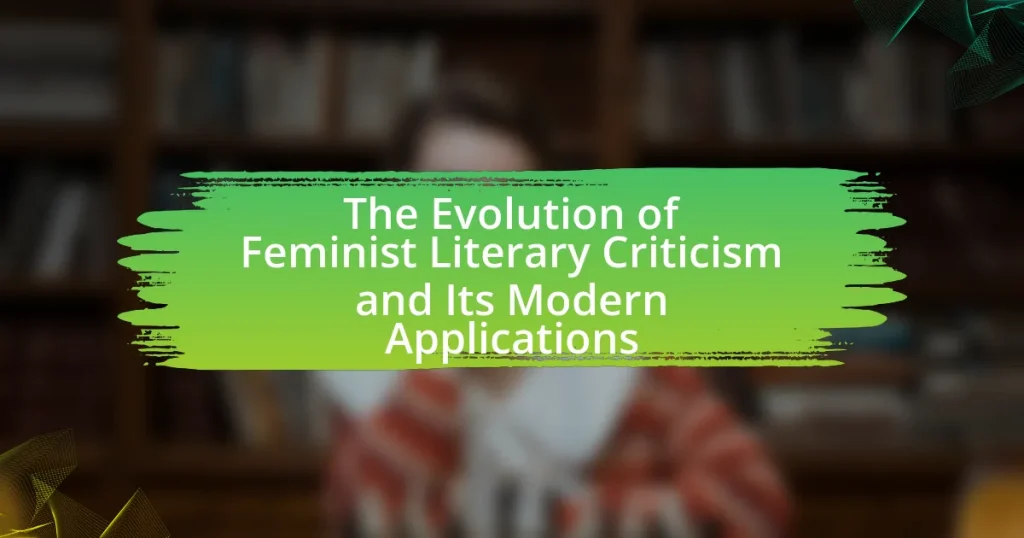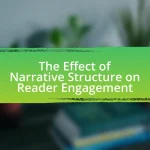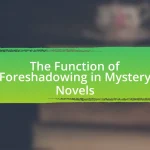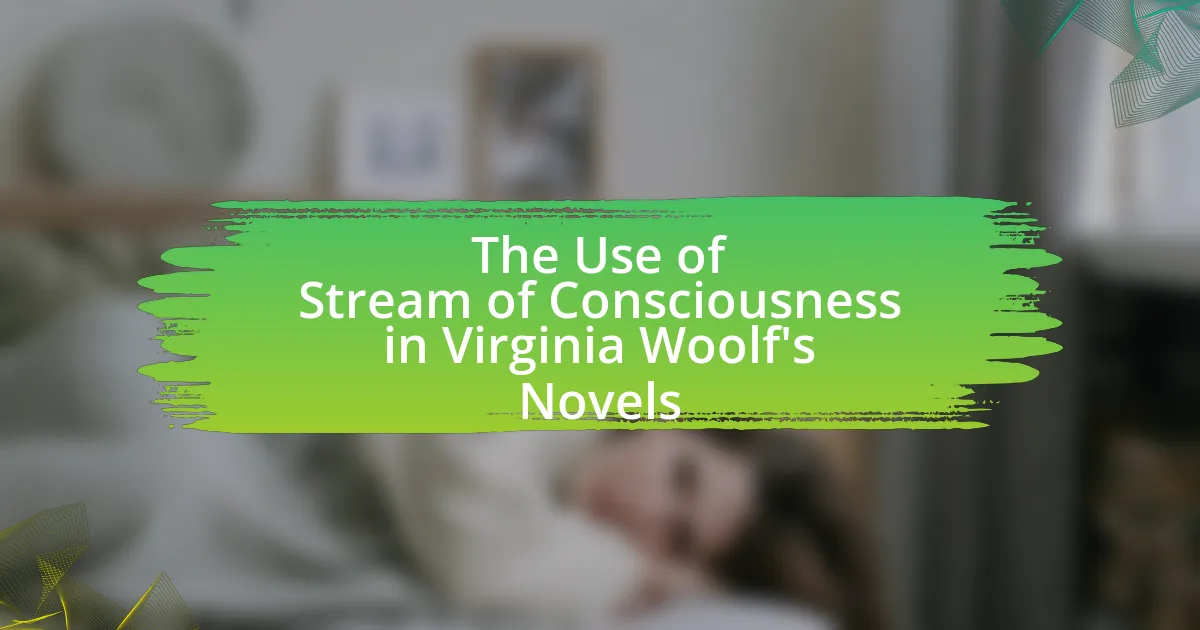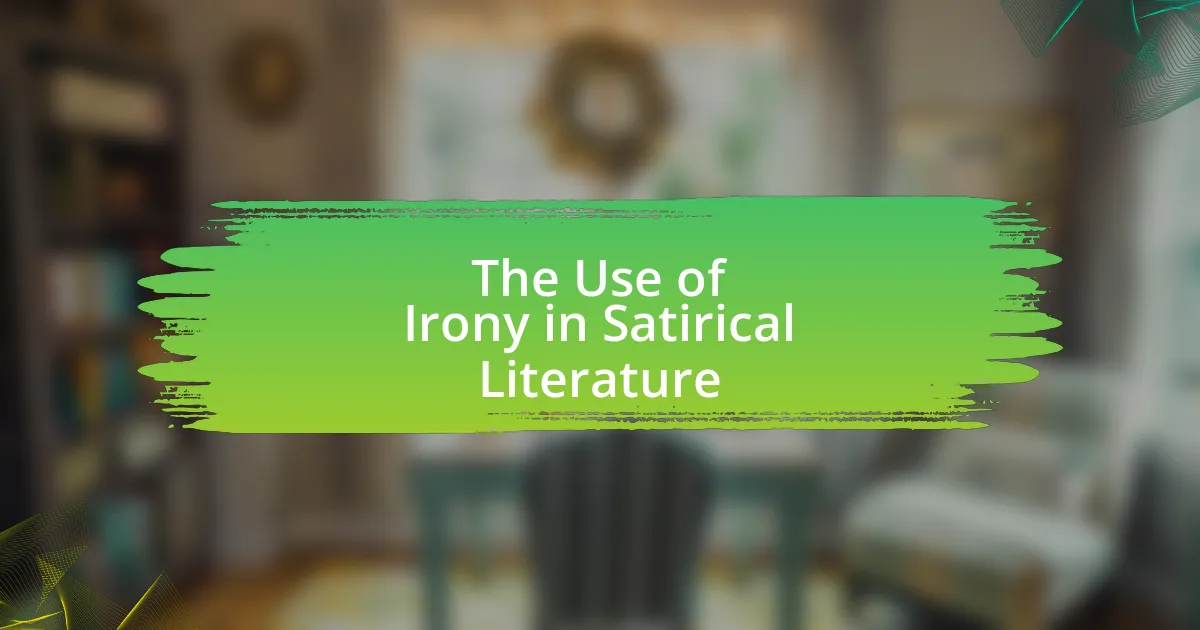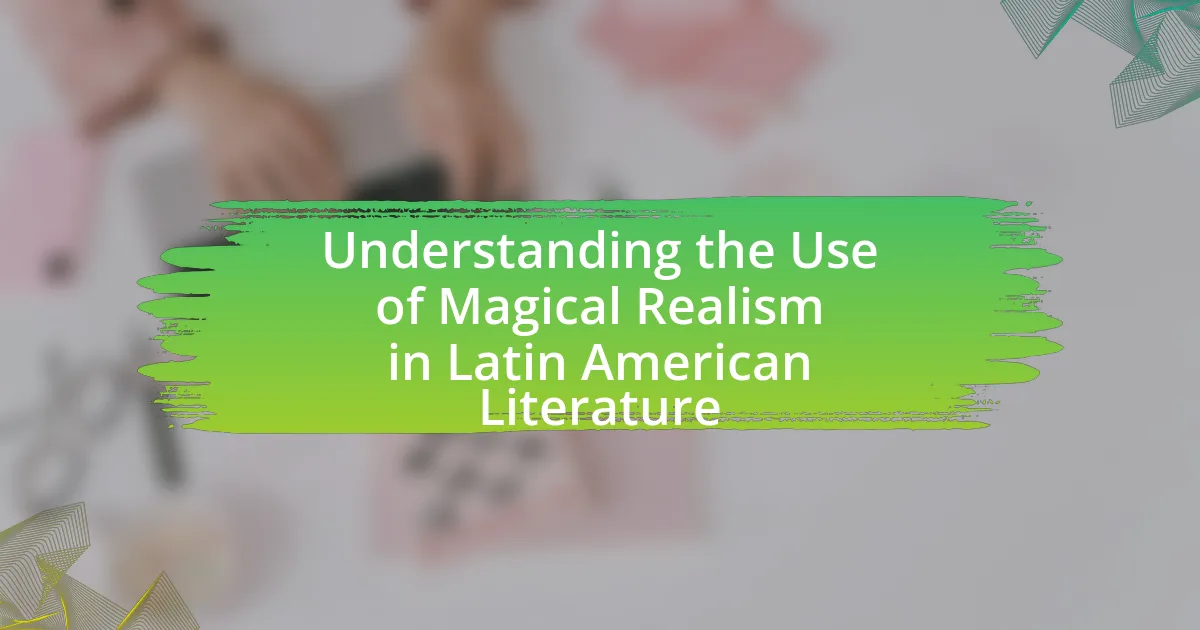The article examines the evolution of feminist literary criticism, tracing its origins from the late 1960s and early 1970s as a response to the male-dominated literary canon. It highlights key figures such as Elaine Showalter, Sandra Gilbert, and Susan Gubar, and discusses foundational theories including liberal, radical, and intersectional feminism. The article also explores the historical contexts that influenced the field, its modern applications in analyzing contemporary literature, and the challenges faced by feminist critics in academia. Additionally, it addresses future directions for feminist literary criticism, emphasizing the importance of intersectionality and digital platforms in expanding the scope of analysis.
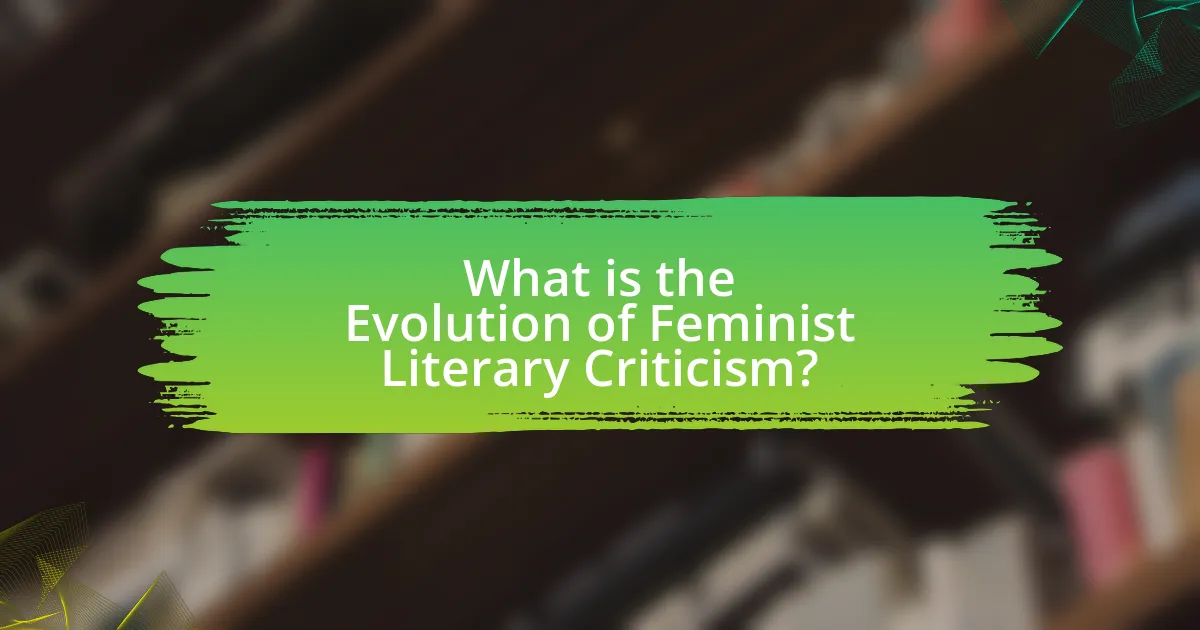
What is the Evolution of Feminist Literary Criticism?
The evolution of feminist literary criticism began in the late 1960s and early 1970s, emerging as a response to the male-dominated literary canon and traditional criticism. Early feminist critics, such as Elaine Showalter and Sandra Gilbert, focused on the representation of women in literature and the ways in which female authors were marginalized. This movement expanded in the 1980s with the incorporation of intersectionality, as scholars like Kimberlé Crenshaw emphasized the importance of race, class, and sexuality in understanding women’s experiences. By the 1990s and into the 21st century, feminist literary criticism has diversified further, integrating postcolonial and queer theories, thus broadening its scope to include a wider range of voices and perspectives. This evolution reflects a growing awareness of the complexities of identity and the need for inclusive analysis in literary studies.
How did feminist literary criticism emerge as a distinct field?
Feminist literary criticism emerged as a distinct field in the late 1960s and early 1970s, driven by the broader feminist movement advocating for women’s rights and gender equality. This emergence was marked by the publication of key texts, such as “The Madwoman in the Attic” by Sandra Gilbert and Susan Gubar in 1979, which analyzed the representation of women in literature and critiqued the male-dominated literary canon. The field gained further legitimacy through academic discourse, with scholars establishing feminist theory as a critical lens to examine literature, focusing on themes of gender, power dynamics, and the social construction of femininity. The establishment of feminist literary criticism as a formal discipline was solidified by the inclusion of feminist perspectives in literary studies curricula and the founding of feminist literary journals, which provided platforms for scholarly work and debate.
What historical contexts influenced the development of feminist literary criticism?
The development of feminist literary criticism was influenced by several historical contexts, including the women’s suffrage movement, the rise of second-wave feminism in the 1960s and 1970s, and the broader cultural shifts surrounding gender equality. The women’s suffrage movement, which gained momentum in the late 19th and early 20th centuries, highlighted the need for women’s voices and perspectives in literature, prompting early feminist critiques. Second-wave feminism, characterized by activists like Betty Friedan and Gloria Steinem, further challenged traditional gender roles and advocated for women’s rights, leading to a more systematic examination of literature through a feminist lens. Additionally, the cultural upheaval of the 1960s, including civil rights movements and anti-war protests, created an environment ripe for questioning established norms, thereby fostering the emergence of feminist literary criticism as a distinct field.
Who were the key figures in the early stages of feminist literary criticism?
Key figures in the early stages of feminist literary criticism include Elaine Showalter, Sandra Gilbert, and Susan Gubar. Elaine Showalter is known for her work “A Literature of Their Own,” which explores women’s writing and its historical context. Sandra Gilbert and Susan Gubar co-authored “The Madwoman in the Attic,” a seminal text that examines female characters in 19th-century literature, highlighting the struggles of women writers. Their contributions laid the groundwork for feminist literary analysis, emphasizing the importance of gender in literary interpretation and the representation of women in literature.
What are the foundational theories of feminist literary criticism?
The foundational theories of feminist literary criticism include liberal feminism, radical feminism, psychoanalytic feminism, and socialist feminism. Liberal feminism focuses on gender equality and advocates for women’s rights within existing social structures, emphasizing the need for equal access to education and employment. Radical feminism critiques patriarchy as a system of oppression and seeks to dismantle it entirely, often exploring themes of female identity and sexuality. Psychoanalytic feminism draws on Freudian and post-Freudian theories to analyze the representation of women in literature and the impact of societal norms on female psychology. Socialist feminism combines Marxist and feminist theories, arguing that capitalism and patriarchy are interconnected systems of oppression that must be addressed simultaneously. These theories have shaped feminist literary criticism by providing diverse frameworks for analyzing texts and understanding women’s roles in literature and society.
How do different feminist theories approach literature?
Different feminist theories approach literature by analyzing texts through various lenses that highlight gender dynamics, power structures, and the representation of women. Liberal feminism focuses on equal representation and access in literature, advocating for women’s voices and experiences to be included in the literary canon. Radical feminism critiques patriarchal structures within texts, emphasizing the need to dismantle male-dominated narratives and highlight women’s oppression. Marxist feminism examines the intersection of capitalism and gender, analyzing how economic factors influence women’s representation in literature. Ecofeminism connects environmental issues with feminist concerns, exploring how literature reflects the exploitation of both women and nature. Each of these theories provides a distinct framework for understanding literature’s role in shaping and reflecting societal attitudes towards gender, thereby enriching feminist literary criticism.
What role does intersectionality play in feminist literary criticism?
Intersectionality plays a crucial role in feminist literary criticism by highlighting how various social identities, such as race, class, gender, and sexuality, intersect to shape individual experiences and perspectives. This approach allows critics to analyze texts in a way that acknowledges the complexity of characters and narratives, moving beyond a singular focus on gender. For instance, Kimberlé Crenshaw, who coined the term “intersectionality,” emphasizes that understanding the overlapping systems of oppression is essential for a comprehensive critique of literature. By applying intersectional analysis, feminist literary criticism can reveal how power dynamics operate within texts, thus providing a more nuanced understanding of both the literature and the societal contexts in which it exists.
Why is the evolution of feminist literary criticism significant?
The evolution of feminist literary criticism is significant because it has transformed the understanding of literature by highlighting gender biases and advocating for women’s voices. This critical approach emerged in the late 20th century, challenging traditional literary canons that often marginalized female authors and perspectives. For instance, scholars like Elaine Showalter and Sandra Gilbert have emphasized the importance of women’s experiences in literature, leading to a broader recognition of female authors and themes. This evolution has not only enriched literary analysis but has also influenced social discourse, promoting gender equality and awareness in both literature and society.
How has feminist literary criticism changed the way we read texts?
Feminist literary criticism has fundamentally transformed the way we read texts by emphasizing the importance of gender dynamics and the representation of women in literature. This critical approach encourages readers to analyze how texts reflect, reinforce, or challenge societal norms regarding gender roles. For instance, feminist critics like Elaine Showalter and Sandra Gilbert have highlighted the marginalization of female voices in literature, prompting readers to reconsider the narratives and perspectives that have traditionally dominated literary discourse. This shift has led to a more inclusive understanding of literature, where the experiences and contributions of women are recognized and valued, thereby enriching the overall interpretation of texts.
What impact has feminist literary criticism had on literary canon formation?
Feminist literary criticism has significantly reshaped literary canon formation by challenging traditional narratives and advocating for the inclusion of women’s voices and experiences. This critical approach has led to the reevaluation of texts previously deemed canonical, highlighting the contributions of female authors and the importance of gender in literary analysis. For instance, the work of feminist critics like Elaine Showalter and Sandra Gilbert has brought attention to overlooked female writers, resulting in a broader and more inclusive literary canon that reflects diverse perspectives. This shift has been evidenced by the increased recognition of authors such as Virginia Woolf and Toni Morrison in academic curricula and literary discussions, demonstrating the lasting impact of feminist literary criticism on the formation of the literary canon.

What are the Modern Applications of Feminist Literary Criticism?
Modern applications of feminist literary criticism include analyzing contemporary literature through the lens of gender dynamics, exploring representation and voice in texts, and critiquing societal norms and power structures. This approach allows scholars and readers to examine how gender influences narrative, character development, and thematic elements in works by both male and female authors. For instance, feminist literary critics often focus on the portrayal of women in literature, assessing how these representations reflect or challenge patriarchal values. Additionally, feminist criticism is applied in the study of intersectionality, considering how race, class, and sexuality intersect with gender in literary texts. This multifaceted analysis is supported by various academic works, such as “Gender Trouble” by Judith Butler, which explores the performative nature of gender, and “The Madwoman in the Attic” by Sandra Gilbert and Susan Gubar, which examines the historical context of women’s writing. These texts illustrate the ongoing relevance and adaptability of feminist literary criticism in understanding modern literature and culture.
How is feminist literary criticism applied in contemporary literature analysis?
Feminist literary criticism is applied in contemporary literature analysis by examining texts through the lens of gender dynamics, power structures, and representation of women. This approach critiques the portrayal of female characters, the roles assigned to them, and the underlying ideologies that shape these narratives. For instance, scholars analyze how contemporary works challenge traditional gender roles or reinforce patriarchal norms, as seen in novels like “The Handmaid’s Tale” by Margaret Atwood, which critiques societal control over women’s bodies and autonomy. Additionally, feminist literary criticism often incorporates intersectionality, considering how race, class, and sexuality intersect with gender in literary texts, thereby enriching the analysis and understanding of diverse female experiences. This method has gained traction in academic discourse, as evidenced by the increasing number of feminist readings in literary journals and conferences, highlighting its relevance in contemporary literary studies.
What methodologies are commonly used in modern feminist literary criticism?
Modern feminist literary criticism commonly employs methodologies such as gender studies, intersectionality, and psychoanalytic theory. Gender studies analyze texts through the lens of gender roles and representations, highlighting how literature reflects and shapes societal norms regarding femininity and masculinity. Intersectionality examines how overlapping social identities, including race, class, and sexuality, influence the experiences of women in literature, emphasizing the complexity of identity. Psychoanalytic theory explores the unconscious motivations of characters and authors, often revealing underlying gender dynamics and power structures. These methodologies collectively enhance the understanding of literature’s role in perpetuating or challenging patriarchal ideologies.
How do modern feminist critics address issues of representation in literature?
Modern feminist critics address issues of representation in literature by analyzing the portrayal of gender, race, and class in texts to highlight systemic biases and advocate for diverse voices. They examine how traditional narratives often marginalize women and other underrepresented groups, emphasizing the need for inclusive storytelling that reflects a broader spectrum of experiences. For instance, scholars like Judith Butler and bell hooks have critiqued the lack of intersectionality in literary criticism, arguing that representation must account for the complexities of identity. Their work underscores the importance of recognizing how literature shapes societal norms and influences perceptions of gender roles, thereby pushing for a more equitable literary canon.
What role does feminist literary criticism play in academia today?
Feminist literary criticism plays a crucial role in academia today by challenging traditional literary canon and promoting diverse voices, particularly those of women and marginalized groups. This critical approach examines texts through the lens of gender, revealing how literature reflects and shapes societal norms regarding gender roles and power dynamics. For instance, feminist literary criticism has influenced curriculum development, leading to the inclusion of works by female authors and texts that address gender issues, thereby enriching literary studies. Additionally, it fosters critical discussions about representation and identity, encouraging students and scholars to interrogate the implications of gender in literature.
How are feminist literary theories integrated into literary curricula?
Feminist literary theories are integrated into literary curricula through the inclusion of texts that highlight women’s experiences and perspectives, as well as critical frameworks that analyze gender dynamics in literature. This integration often involves the selection of works by female authors, such as Virginia Woolf and Toni Morrison, and the application of feminist critical approaches that challenge traditional interpretations of texts. Research indicates that curricula incorporating feminist theories enhance students’ understanding of gender issues and promote critical thinking about societal norms, as evidenced by studies showing improved engagement and analytical skills among students exposed to feminist literary criticism.
What challenges do feminist literary critics face in academic settings?
Feminist literary critics face several challenges in academic settings, including institutional resistance, marginalization of feminist perspectives, and the need for interdisciplinary approaches. Institutional resistance often manifests in the form of a lack of support for feminist scholarship, which can limit funding and resources for research. Marginalization occurs when feminist theories are sidelined in favor of traditional literary criticism, leading to a diminished presence in curricula and academic discourse. Additionally, the complexity of feminist issues requires interdisciplinary approaches that may not align with conventional academic structures, making it difficult for critics to effectively engage with and promote feminist literary analysis. These challenges hinder the advancement and recognition of feminist literary criticism within academia.
How does feminist literary criticism intersect with other critical approaches?
Feminist literary criticism intersects with other critical approaches by examining how gender influences literature and its interpretation, often aligning with postcolonial, psychoanalytic, and Marxist theories. For instance, feminist critics utilize postcolonial theory to analyze how colonial narratives perpetuate gendered oppression, as seen in works by authors like Chandra Talpade Mohanty. Additionally, feminist psychoanalytic criticism explores the representation of female subjectivity in literature, drawing on theorists such as Julia Kristeva. Marxist feminist criticism further critiques the intersection of capitalism and patriarchy, highlighting how economic structures impact women’s representation in literature. These intersections enrich literary analysis by providing a multifaceted understanding of texts and their societal implications.
What are the synergies between feminist literary criticism and postcolonial theory?
Feminist literary criticism and postcolonial theory share synergies in their focus on the intersectionality of gender, race, and colonialism. Both frameworks critique the dominant narratives that marginalize women and colonized subjects, emphasizing the need to deconstruct patriarchal and imperialist ideologies. For instance, feminist literary critics often analyze how colonialism has shaped gender roles and identities, while postcolonial theorists examine the ways in which gender influences the experiences of colonized women. This mutual concern for the complexities of identity and power dynamics allows for a richer understanding of texts that reflect both feminist and postcolonial contexts, as seen in works by authors like Chimamanda Ngozi Adichie and Arundhati Roy, who address these intertwined issues in their narratives.
How does feminist literary criticism engage with queer theory?
Feminist literary criticism engages with queer theory by examining how gender and sexuality intersect in literature, challenging traditional binaries and norms. This engagement allows for a more nuanced understanding of texts, as feminist critics analyze how patriarchal structures influence representations of queer identities. For instance, scholars like Judith Butler argue that gender is performative, which aligns with feminist critiques of fixed gender roles, thereby enriching both fields. Additionally, queer theory’s focus on fluidity complements feminist literary criticism’s exploration of women’s experiences, leading to a broader critique of societal norms surrounding both gender and sexuality.

What are the Future Directions of Feminist Literary Criticism?
The future directions of feminist literary criticism include an increased focus on intersectionality, digital feminism, and global perspectives. Intersectionality will enhance the analysis of how various social identities, such as race, class, and sexuality, intersect with gender in literature, as highlighted by scholars like Kimberlé Crenshaw. Digital feminism will explore how online platforms shape feminist narratives and activism, reflecting the growing influence of social media on literary discourse. Additionally, a global perspective will broaden the scope of feminist criticism by incorporating diverse cultural contexts, as seen in the works of authors from non-Western backgrounds, thereby challenging Eurocentric narratives. These directions indicate a dynamic evolution in feminist literary criticism, adapting to contemporary social changes and technological advancements.
How might feminist literary criticism evolve in the coming years?
Feminist literary criticism is likely to evolve by increasingly incorporating intersectionality, focusing on how various social identities such as race, class, and sexuality intersect with gender. This evolution is supported by the growing recognition of diverse voices within feminist discourse, as seen in the rise of authors like Chimamanda Ngozi Adichie and Roxane Gay, who challenge traditional narratives. Additionally, the integration of digital humanities tools will enable more nuanced analyses of texts, allowing critics to explore gender representation across different media and genres. This shift reflects a broader societal movement towards inclusivity and complexity in understanding gender dynamics.
What emerging trends are shaping the future of feminist literary criticism?
Emerging trends shaping the future of feminist literary criticism include intersectionality, digital feminism, and the focus on global perspectives. Intersectionality emphasizes the interconnectedness of gender with race, class, and sexuality, allowing for a more nuanced analysis of texts. Digital feminism leverages online platforms to amplify feminist voices and critique literature, fostering community engagement and activism. Additionally, a growing emphasis on global perspectives highlights the diverse experiences of women across cultures, challenging Eurocentric narratives. These trends reflect a shift towards inclusivity and adaptability in feminist literary criticism, responding to contemporary social dynamics and technological advancements.
How can feminist literary criticism adapt to digital and global contexts?
Feminist literary criticism can adapt to digital and global contexts by utilizing online platforms to amplify diverse voices and perspectives. Digital tools enable feminist critics to engage with a broader audience, facilitating discussions that transcend geographical boundaries. For instance, social media allows for real-time dialogue and the sharing of feminist texts, while digital archives provide access to previously marginalized literature. Furthermore, global feminist movements can influence literary criticism by incorporating intersectional analyses that consider race, class, and sexuality, reflecting the complexities of contemporary society. This adaptability is evidenced by the rise of digital feminist publications and online communities that challenge traditional literary canons and promote inclusive narratives.
What practical strategies can be employed in feminist literary criticism today?
Practical strategies employed in feminist literary criticism today include intersectional analysis, which examines how various social identities such as race, class, and sexuality intersect with gender. This approach allows critics to understand the complexities of women’s experiences in literature more comprehensively. Additionally, close reading techniques are utilized to uncover underlying gender biases and power dynamics within texts, revealing how language and narrative structures perpetuate or challenge patriarchal norms. Furthermore, engaging with contemporary feminist theory, such as the works of Judith Butler and bell hooks, provides critical frameworks for analyzing texts through a modern lens. These strategies are validated by the increasing recognition of diverse voices in literature, as seen in the rise of authors like Chimamanda Ngozi Adichie and Roxane Gay, who challenge traditional narratives and expand the scope of feminist discourse.
How can readers apply feminist literary criticism to their own reading practices?
Readers can apply feminist literary criticism to their own reading practices by actively analyzing texts for gender representation, power dynamics, and the portrayal of female characters. This approach encourages readers to question traditional narratives and consider how societal norms influence literature. For instance, examining the roles and agency of women in classic and contemporary works can reveal underlying biases and assumptions about gender. Research by Elaine Showalter highlights the importance of recognizing the historical context of female authors and their contributions to literature, which further supports the application of feminist perspectives in reading. By engaging with these critical frameworks, readers can develop a deeper understanding of the texts and their implications regarding gender and society.
What resources are available for those interested in feminist literary criticism?
Key resources for those interested in feminist literary criticism include foundational texts, academic journals, and online platforms. Foundational texts such as “The Madwoman in the Attic” by Sandra Gilbert and Susan Gubar and “Gender Trouble” by Judith Butler provide critical frameworks and historical context. Academic journals like “Signs: Journal of Women in Culture and Society” and “Feminist Studies” publish peer-reviewed articles that explore contemporary feminist literary theory and criticism. Online platforms such as the Modern Language Association (MLA) and the Association for the Study of Literature and Environment (ASLE) offer access to resources, conferences, and networking opportunities for scholars in the field. These resources collectively support the study and application of feminist literary criticism.
